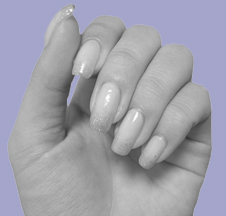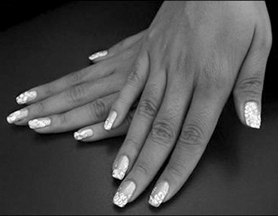 1.
Never push back dry cuticles
Doing so can crack polish at the base, which leads to chipping. But
if you're about to change your polish, you don't want any cuticle skin
on the nail's surface (it can interfere with your base coat) - so loosen
ragged edges by rubbing in a softening cream. (Eg. a Multi-Vitamin Creme.)
Then gently nudge cuticles back with an orangewood stick.
2. Don't soak fingertips
There's no real reason to do so (at salons, it's just part of the
pampering), and it can actually have a negative effect. When you soak
your nails, they absorb water, which temporarily puffs them up - but
they revert to their normal shape when the water evaporates. This
expansion and contraction is the top cause of chipping, peeling, and
cracking of polish.
 3.
Get the surface clean 3.
Get the surface clean
Any traces of moisture, dust, or leftover enamel will get in the way
of new-polish adhesion. To pave the way for true staying power, drizzle
an old toothbrush with hand soap; then use it to get into the corners
and under nail tips, where oil - the great enemy - may be hiding. Then
swipe on an acetone polish remover to temporarily dehydrate the nail
plate. (Try advanced nail polish remover.)
4. Shape up
To maximize nail strength, tips should be rounded and corners left
somewhat square. Filing is healthier than clipping, which can crack the
nail plate. Use a fine-grit nail file and work in one direction. Filing
back and forth with an abrasive board will cause the nail's delicate
keratin layers to peel away from each other.
5. Apply a base coat
Not only does a bottom layer give lacquer something to latch on to,
but studies show that a base coat sticks to nails better than polish
does. For uneven nail surfaces, choose a base that also smooths out
roughness.
6. Once lacquer is on, seal it with a slow-setting topcoat
Quick-dry kinds are certainly appealing, but they evaporate so fast,
they leave polish soft, mushy, and are prone to denting. A slower-acting
topcoat leaves a harder, more protective finish. To speed things up
without sacrificing protection, use a drying oil or spray over your
topcoat.
7. Make the most of metallics
Sure, light shades make chips less noticeable, but you can get an
extra couple of days' wear out a metallic polish.
One theory on why this works: Small iridescent flecks thicken enamel,
so it forms a stronger film as it dries - allowing it to outlast creamy
opaques (whose high pigment content can block adhesion).
8. Polish
Polish should be applied in three narrow, even strokes - one down the
centre and one down each side - and then be allowed to dry for two
minutes before a second coat is applied. The thicker the layer is, the
more difficult it is for the solvent - the liquid agent in enamel - to
evaporate, boosting the chances that polish will peel.
9. Practise good maintenance.
Everything you touch wears away your polish. Every other day, apply a
layer of quick-dry topcoat (it's OK to use on already-dry polish) to
form a protective shield and increase shine.
10. Give your polish a drink
The more your enamel dries out, the greater the likelihood that it
will separate from your nail. Since topcoats don't seal in hydration,
apply oil to nails and cuticles before bedtime, and slather on a thick
hand cream twice a day.
 Simple
tricks to sexier hands Simple
tricks to sexier hands
Did your genes stick you with what one Seinfeld episode called "man
hands"? Here, three ways to fake long and slender.
1. Colour.
Pastel polish shades (think lavender) slim down chubby fingers.
2. Shape.
Overly blunt or square edges make nails look shorter. Round or oval
shapes create the illusion of length.
3. Style.
Because it accentuates nail tips, a French manicure visually extends
your fingers. But the "backward" French - in which the coordinating
colour is painted on your moon - can make short fingers look stubbier. |

